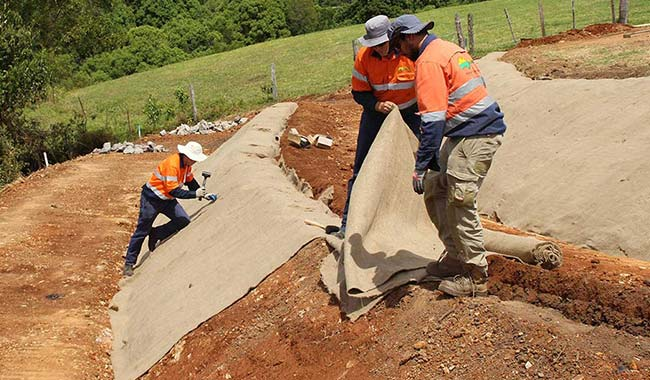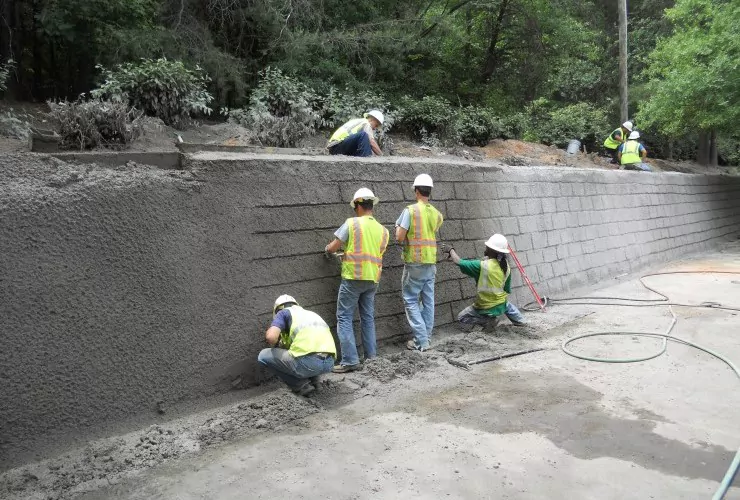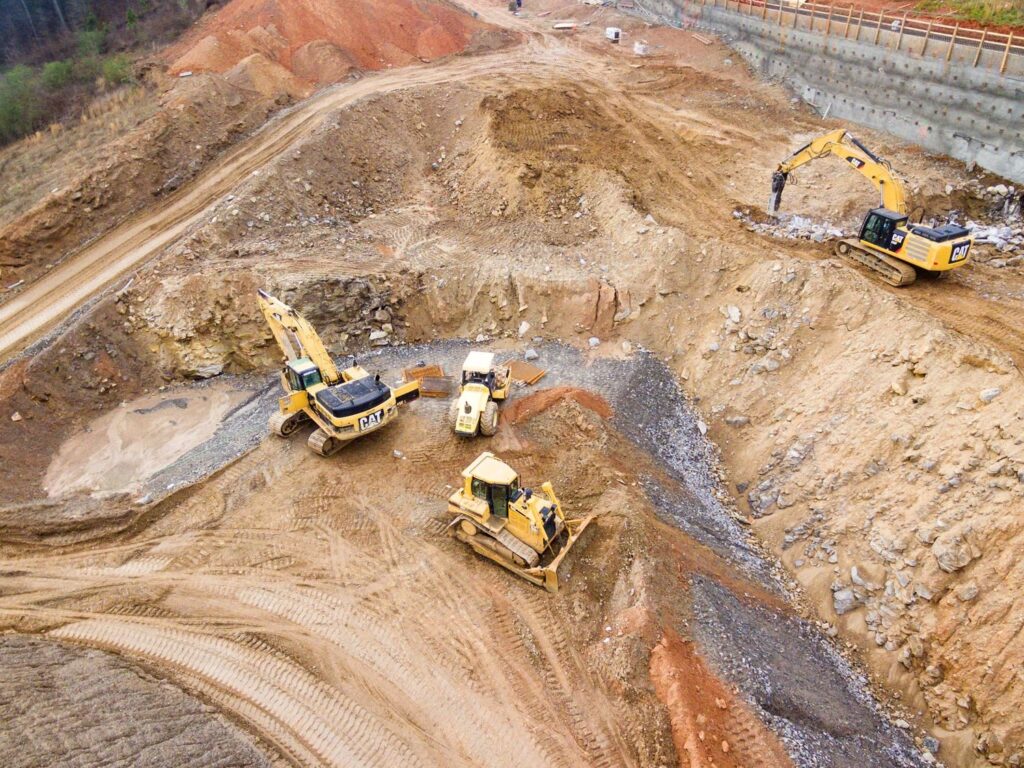Managing soil erosion on construction sites is crucial for maintaining soil quality, protecting the environment, and ensuring the success of construction projects. Soil erosion can lead to significant environmental degradation, including water pollution, loss of fertile topsoil, and increased sedimentation in nearby water bodies. Effective erosion and sediment control practices are essential to prevent these issues and ensure compliance with environmental regulations.

At RJT Construction, we specialize in advanced erosion control methods, drawing on years of experience to mitigate soil erosion on construction sites. Our expertise ensures that construction projects remain environmentally friendly and sustainable.
Soil erosion refers to the displacement of the upper layer of soil, primarily caused by wind, water, and human activities. Erosion control involves various practices aimed at preventing soil loss, while sediment control focuses on capturing eroded soil before it leaves the construction site.
Understanding Soil Erosion in Construction Sites
Soil erosion is the process by which soil is removed from the ground’s surface by wind or water. On construction sites, soil erosion can be exacerbated by earth-moving activities, removal of vegetation, and changes in land levels.
The impact of soil erosion on construction sites is profound. It not only depletes the soil of its essential nutrients but also leads to sediment-laden runoff, which can cause water pollution in nearby water bodies. Furthermore, the loss of soil can destabilize the land, creating unsafe conditions for construction projects and potentially leading to delays and increased costs.
Common Erosion Control Methods
Effective erosion control is essential for maintaining soil integrity and preventing environmental damage on construction sites. Common erosion control methods include the use of erosion control blankets, silt fences, and sediment control practices. These methods help to stabilize the soil, reduce runoff velocity, and trap sediments.
Implementing these erosion control practices is crucial for the success of construction projects. They not only protect the environment but also help in maintaining the quality of the soil, ensuring that construction activities can proceed smoothly. By reducing the risk of soil erosion, construction sites can avoid costly remediation efforts and comply with environmental regulations.
Soil Erosion Control Techniques
Several techniques are available to prevent soil erosion on construction sites. One effective approach is the use of erosion control blankets, which help to stabilize the soil and promote vegetation growth. Silt fences are another valuable tool, designed to capture sediment while allowing water to flow through.
Sediment basins are essential for managing large volumes of runoff and trapping sediments before they leave the construction site. These basins are temporary structures that provide immediate protection against soil erosion and help in controlling sediment movement. By implementing these techniques, construction sites can significantly reduce the risk of soil erosion and protect the surrounding environment.
Sediment Control Practices
Sediment control is crucial for preventing soil particles from being washed off construction sites and into water bodies. Effective sediment control practices capture and manage sediment-laden runoff, ensuring minimal environmental impact.
Key techniques for sediment control on construction sites include the use of silt fences, sediment traps, and temporary sediment basins.
- Silt fences are permeable barriers that filter out sediment while allowing water to pass through.
- Sediment traps are small, temporary ponds that capture sediment-laden runoff, allowing sediments to settle before the water is discharged.
- Temporary sediment basins are larger, more permanent solutions designed to handle substantial runoff and provide extended sediment control.
By implementing these techniques, construction sites can effectively manage sediment and comply with regulatory requirements.
Utilizing Natural Vegetation for Erosion Control
Natural vegetation plays a vital role in controlling erosion on construction sites. Vegetative cover stabilizes soil, reduces runoff velocity, and enhances soil quality through root systems that bind the soil together.
To establish vegetation on construction sites, it’s essential to choose appropriate plant species that are resilient and suited to the local climate and soil conditions. Seeding and hydroseeding are common methods for planting vegetation. Seeding involves directly sowing seeds into the soil, while hydroseeding combines seeds with water and mulch to promote faster growth.
Maintaining existing vegetation and minimizing soil disturbance also contribute to effective erosion control. By leveraging natural vegetation, construction sites can achieve sustainable erosion management and improve environmental outcomes.
Managing Wind Erosion on Construction Sites
Wind erosion can be a significant issue on construction sites, especially in arid or exposed areas. Wind erosion not only removes topsoil but also contributes to air pollution and reduced soil quality.
Strategies to control wind erosion include using windbreaks, such as trees or fences, to reduce wind speed and protect the soil. Applying water to the soil can also help to prevent dust particles from becoming airborne.

Additionally, soil stabilizers and mulching can provide immediate protection against wind erosion by creating a protective layer over the soil. Regularly maintaining these measures ensures ongoing protection against wind erosion throughout the construction process.
Water and Wind Erosion Control Methods
An integrated approach to managing both water and wind erosion is essential for comprehensive erosion control on construction sites. Combining various methods ensures effective protection against all erosion forces.
Erosion control blankets are versatile tools that can mitigate both water and wind erosion. These blankets provide a protective layer over the soil, reducing runoff velocity and preventing soil displacement by wind.
Articulated concrete blocks are another effective solution, particularly on steep slopes, as they provide stability and allow for water drainage without causing erosion. By implementing a combination of these methods, construction sites can achieve robust erosion control and maintain environmental integrity.
Temporary Erosion Control Solutions
Temporary erosion control solutions are essential during the construction phase to prevent immediate soil erosion and sediment displacement. These measures provide short-term protection until permanent erosion control practices can be established.
Temporary sediment basins are crucial for capturing and containing sediment-laden runoff, allowing sediments to settle before the water is released. Turbidity barriers, also known as silt curtains, are used in water bodies to control sediment spread and protect aquatic life.
These barriers are effective in containing sediments and preventing water pollution. Implementing these temporary solutions ensures construction sites remain compliant with environmental regulations and minimizes the impact on surrounding areas.
The Role of Drainage Channels in Erosion Control
Drainage channels play a vital role in reducing soil erosion by directing runoff water away from vulnerable areas and into controlled outlets. These channels prevent water from accumulating on construction sites, thereby reducing the risk of erosion and sediment displacement.
Best practices for implementing drainage channels include designing them with appropriate slopes to ensure effective water flow and using erosion-resistant materials to line the channels. Regular maintenance is essential to prevent blockages and ensure the channels function efficiently. By effectively managing runoff water, drainage channels help protect soil integrity and enhance the overall stability of construction sites.
Stabilizing Slopes to Prevent Erosion
Slope stabilization is critical for preventing erosion on construction sites, especially those with steep gradients. Unstable slopes are prone to soil displacement and can lead to significant environmental and structural issues.

Techniques for slope stabilization include the use of soil nails and retaining walls. Soil nails are long, slender rods inserted into the soil to reinforce and stabilize the slope. Retaining walls provide physical barriers that hold back soil and prevent erosion.
These structures can be made from various materials, including concrete, stone, and timber. Implementing these techniques ensures that slopes remain stable and resistant to erosion, protecting both the construction site and the surrounding environment.
Managing Erosion with Construction Vehicles and Equipment
Construction activities and the use of heavy vehicles and equipment can significantly impact soil erosion. The movement of vehicles can disturb the soil, increase soil exposure, and contribute to erosion.
Best practices for minimizing erosion caused by construction vehicles and equipment include creating designated pathways to limit soil disturbance and using temporary ground covers to protect exposed soil. Additionally, implementing inlet protection devices around storm drains can prevent sediment from entering the drainage system.
Regular maintenance of equipment to prevent leaks and spills also reduces the risk of soil contamination. By adopting these practices, construction sites can minimize the impact of vehicles and equipment on soil erosion and maintain environmental compliance.
Effective Strategies to Stabilize Slopes and Prevent Soil Erosion on Construction Sites
Stabilize Slopes to Prevent Erosion
Stabilizing slopes is a critical aspect of preventing soil erosion on construction sites. Unstable slopes are prone to earth movement, which can significantly increase erosion. Techniques such as installing retaining walls and using soil nails help reinforce the soil and maintain slope stability. Articulated concrete blocks and erosion blankets are also effective methods for slope stabilization.

These materials provide structural support and protect against water runoff, thereby reducing erosion risk. Ensuring that slopes remain undisturbed and implementing these stabilization techniques can greatly enhance erosion protection.
Preventing Soil Erosion with Vegetative Cover
Vegetative cover is an essential component in protecting soil from erosion. Planting vegetation helps stabilize soil through root systems that bind the soil together, preventing it from being washed away by water or blown away by wind. Establishing vegetative cover can be achieved through methods likeseeding and hydroseeding.
It is crucial to ensure that the area remains undisturbed during the establishment phase to allow the vegetation to take root effectively. Natural areas with established vegetation are less prone to erosion, making this an effective long-term strategy for erosion protection.
The Role of Concrete Blocks and Earth Walls
Concrete blocks and earth walls play a significant role in erosion control on construction sites. Concrete blocks, such as articulated concrete blocks, are used to create stable, erosion-resistant surfaces on slopes and other vulnerable areas.
These blocks help divert upslope water and reduce runoff velocity, which can otherwise cause soil displacement. Earth walls, on the other hand, provide a natural and robust barrier against erosion. These structures support the soil and prevent it from being carried away by water or wind.
Erosion Blankets and Drain Tiles for Erosion Control
Erosion blankets are a temporary measure used to protect disturbed soil from erosion. These blankets cover exposed soil, providing immediate protection against water and wind erosion. They are particularly useful during construction phases when the soil is most vulnerable.

Additionally, drain tiles can be installed to manage water runoff and prevent soil saturation, which can lead to erosion. Drain tiles help control sediments by directing water away from critical areas, thus maintaining soil stability.
Managing Construction Erosion and Protecting Natural Areas
Construction erosion is a significant challenge that requires proactive management to protect soil and natural areas. Using appropriate construction equipment and implementing best practices can minimize soil disturbance and erosion.
For example, creating designated pathways for construction vehicles can limit the area affected by earth movement. Regular sediment removal from drainage channels and sediment basins ensures that sediments do not accumulate and exacerbate erosion problems.





